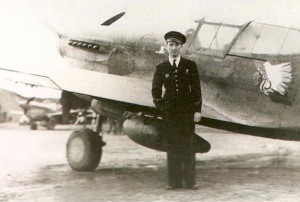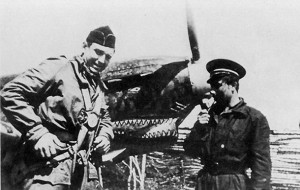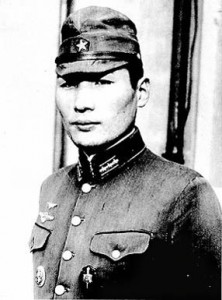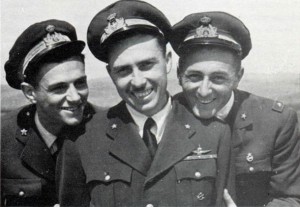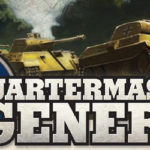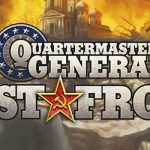The Wings of Glory WW2 Starter Set will be released in February 2012 and will include everything that new players need to start playing the game.
Four exclusive versions of the Curtis P-40 Warhawk, Yakovlev Yak-1, Kawasaki Ki-61 and Reggiane Re.2001 models will be included.
In this preview, we will focus on the pilots and units of the specific airplanes included in this starting set.
Jean Gisclon’s P-40F Warkawk is a fighter that took part in the Tunisian campaign, in early 1943 . Gisclon was Sergent Chef of the Groupe de Chasse II/5, known as the “Lafayette” fighter group, of the Forces Aériennes Françaises Libres – the air force of the Free French troops, formed by French partisans who decided to continue to fight against the forces of the Axis powers after the surrender of France and its subsequent German occupation.
Born in Lyon in April 1913, Jean Gisclon became a military pilot in September 1932 and performed 300 war missions during WW2, with two individual victories, including some in collaboration (two or three, depending on the source). He started his career in 1933 at the 35th Aviation Regiment, based in Lyon, and joined the Group de Chasse II/5 on June 1937, participating to the French Campaign in March 1940, when he achieved his first victories.
On November 8th, 1942, the Americans landed in North Africa and the GC "Lafayette",equipped with Curtiss P.40 aircrafts, was soon involved in the Tunisian campaign (from January 8 to March 15, 1943). Gisclon, already an ace, achieved another victory. After that, he also took part in operations in Corsica (Italian campaign) and in France. After the end of the war, Gisclon continued his military career until 1960, when he left the Air Force. As a civilian, Gisclon became a journalist, writing for 20 years for the newspaper “Le Parisien”, and published a dozen books about WW2 campaigns and operations. He died in 2009.
The Yakovlev Yak-1 included in the Starter Set is the shark-mouthed airplane piloted by another French ace, the Sous Lieutenant Albert Durand, at the Groupe de Chasse 3 Normandie-Niemen. The aircraft was used at Mosalsk in April 1943 by this fighter group, formed by the French pilots that Charles de Gaulle sent to Russia to help the Soviet war efforts.
Albert Durand was born on September 16th, 1918, at Grasse, and became a fighter pilot on July 1938, at Nimes. Detached to the GC III/1at Sidi-Ahmed in 1939, he achieved his first victory, opening the winnings score of his squadron. Following the armistice, his fighter group was dissolved.
Together with Marcel Albert and Marcel Lefèvre, he decided to try to reach Gibraltar on a D520 training flight. The operation was successful and the three pilots were transferred to Great Britain. Following a training period at Camberley, Duran was assigned to the Normandie regiment.
The campaign started on April 1943, and together with Albert Preziosi he opened the long list of victories of the Normandie-Niemen group. Considered one of the best pilots of the group, he had an outstanding performance at the fierce battle of Orel. In five months, Durand achieved other five victories, scoring a total of 10 confirmed wins (4 individual, 6 in team).
On September 1st, 1943, Durand disappeared during a mission over Ielnia, in the USSR. He was less than 25 years old, with 180 war missions completed.
The B-29 hunter Teruhiko Kobayashi, of 244th Sentai, achieved six victories with the Kawasaki Ki-61-I-KAIc Hien featured in the Wings of Glory Starter Set. Born in 1920, Kobayashi entered the Military Army Academy in the late 1930’s and became the youngest Sentai commander of the Japanese Army Air Force (JAAF), at the age of 24.
Kobayashi started his career in the JAAF as a light bomber pilot over China. He participated at the bombing of Hong Kong on the opening day of the Pacific War and in April 1943 he was already an experienced pilot of the 66th Sentai in Manchuria.
In November 1944, he was promoted to Captain and by the end of that month he was assigned as an assistant to the commander of the 244th Sentai. This group, based at the Chofu airfield, was armed with the Ki-61-I-KAI Hien and provided home defense, protecting the Tokyo area from enemy bombers.
Kobayashi rose to fame as commander of the group, which gathered a number of successful B-29’s hunters. He personally shot down one American bomber on December 3rd, 1944, while the group claimed six more aircrafts shot down by ramming attacks in the same sortie - all JAAF pilots survived.
He damaged two “Superfortress” in sorties on December 22nd, 1944, and January 9th, 1945, and on the 27th of that month he destroyed a B-29 through ramming, and escaped from death with his parachute. For this mission, he received the Medal of Honor “Bukosho”.
Kobayashi also escaped martial court on July 1945, after he disobeyed an order to take off for intercepting marauding Hellcats over the Yokaichi airfield, because he had been instructed to stay on the ground to wait for incoming bombers. The martial court was planned and it would assign a serious penalty to him, but the Emperor words approving the pilot’s actions made the charges to be dropped.
Kobayashi scored five victories in total – three B-29s and two Hellcats, although wrong post-war accounts credited him with ten B-29s and two fighters. After the end of war, he joined the Self-Defense Air Force, and he died on June 1957 in a training accident. He was flying a T-33 that crashed during the approach to landing, in bad weather conditions. Before the crash, noticing the technical problems, he ordered to his subordinates to eject from the aircraft, behaving as a hero until the end.
The fourth aircraft featured in the Starter Set is the Reggiane Re.2001 Falco II piloted by Riccardo Vaccari, one of the two fighters modified to carry a special 640 kg-heavy bomb to attack carriers and battleships, also known as Re.2001 G/V – acronym of Galimberti and Vaccari, the two aces who conceived this variant.
Riccardo Vaccari was assigned to the 97a Squadriglia, 9o Gruppo, 4o Stormo on July 8th, 1938. Starting in June 1940, the group operated from different bases – Treviso, Turin, Comiso (Sicily), Tripoli, El Adem, flying Fiat CR.42 aircrafts.
On November 12th, 1940, while based in El Adem, Vaccari performed a reconnaissance mission over the enemy airfield of Maaten Bagush. The following day, he took off at sunset and strafed that airfield, claiming a bomber and three fighters burnt on the ground. The bomber was a Vickers Valentia, one of the only three ground losses admitted by the RAF in the Western Desert during 1940. Vaccari was awarded with a medal of honor for this mission.
On October 1941, he was detached to the Furbara airfield together with Tenente Rinaldo "Aldo" Galimberti to develop an idea they had submitted to the Ministero dell’Aeronautica. They thought that a fast single-engine fighter armed with a hard bomb could be less expensive and more effective than a torpedo-armed bomber.
The aircraft chosen for the trial was the Reggiane Re.2001. The airplane was chosen because its fuselage structure allowed to mount a rack to the underside to attach the bomb, as well as for its strength and maneuverability. In the meanwhile, another experienced torpedo-bomber pilot, Tenente Guido Robone joined them. In the spring 1942, Galimberti died in an accident while doing aerobatic maneuvers - his CR.42 crashed into the sea, close to the shore at Furbara.
After testing an ordinary 500 kg bomb, considered not powerful enough for the duty, Vaccari choose a 381 mm battleship shell, suitably bored to accommodate 120 kg of explosive. This special bomb was named 630 PD (Perforante-Dirompente, or piercing-disruptive). The tests were not completed yet when Vaccari and Robbone were commanded to suspend the trials and transferred from Furbara.
However, on August 12th they had the chance to employ the two Re.2001 G/Vs to attack an enemy convoy with four carriers that had left Gibraltar (Operation Pedestal). After spotting the convoy, Vaccari and Robone dived and maneuvered to perform a 90-degrees attack on the port side of the carrier HMS Victorious. They released the bombs at 80 meters distance from the target and at an altitude of 20 meters at full speed. The bombs hit the ship but, according to some reports, slid on the deck and finished into the sea.
In a post-war interview, Vaccari declared: "I'm absolutely sure that my bomb did not slip on the deck as many wrote. It pierced, or at least knocked, on the ship's side or below the deck. I heard perfectly the bang of the impact that I knew for having heard it many times during tests at Furbara".
Information sources: CielDeGloire.com, Normandie Niemen, Maquette72, e-book "B-29 Hunters of the JAAF" (Henry Sakaida,K?ji Takaki), Hakans Aviation page - Biplane Fighter Aces Italy, Wikipedia, book "Il Caccia Re.2001" (Sergio Govi).


